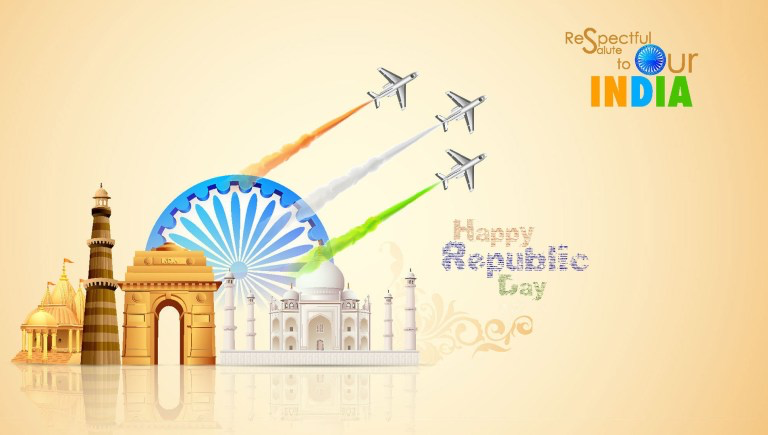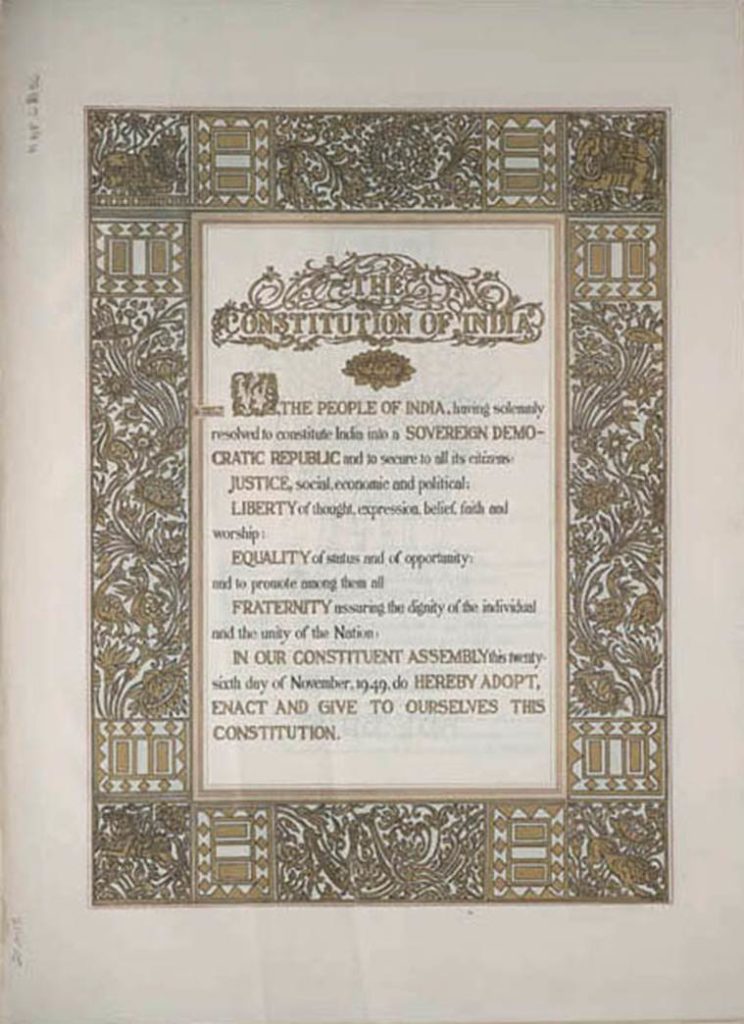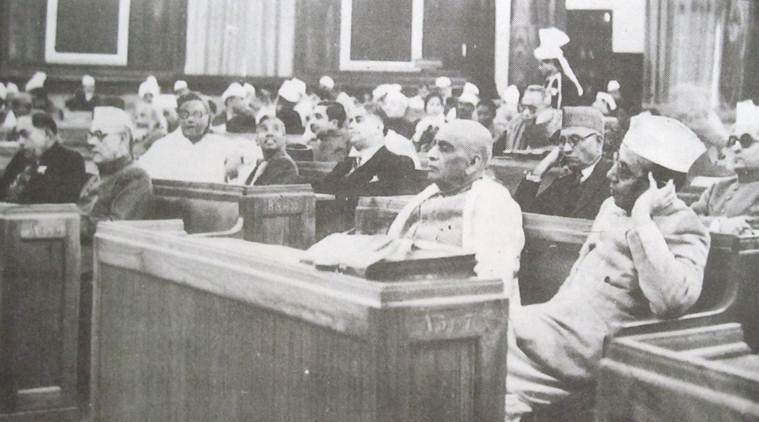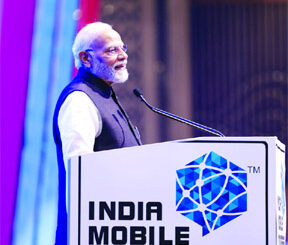
History of January 26; Birth of constitution of India; Grand celebrations
India is a proud Republic, with a vibrant democratic system with the largest constitution of the world, which guarantees inalienable equal rights to all of its nearly 1.3 billion people. But the road to Republic has not been smooth. There was a long struggle to realize the dream of a vast population to be an independent nation and a Republic. Much sweat and blood went in to the struggle.
On December 9, 1946 the Constituent Assembly met for the first time in the Constitution Hall of Parliament House, with the intention of putting together the document that would go on to form the backbone of the independent India’s government. Exuberant and full of hope, the 207 members out of 292 present in the first session started the debate and discussions which would continue for the next three months, culminating in the constitution of India.
British government sent the Cabinet mission to India in 1946 to discuss with Indian leaders, the process for the peaceful transfer of power. As per the guidelines laid down by the mission, provincial legislative elections were held resulting in the nomination of 292 representatives who would go on to form the Constituent Assembly. Those elected included Sardar Vallabhbhai Patel, Maulana Abul Kalam Azad, Sarojini Naidu and Pandit Jawaharlal Nehru, among others. The task at hand was humongous. Resolutions laid out had to take care of aspects like territorial integrity, socio-economic equality, justice of law and minority rights. Setting out the objectives for the Constituent Assembly, Pandit Jawaharlal Nehru said, “The first task of this Assembly is to free India through a new constitution, to feed the starving people, and to clothe the naked masses, and to give every Indian the fullest opportunity to develop himself according to his capacity. This is certainly a great task.”
In the next 3 years, the Constituent Assembly held 11 sessions over 165 days. The draft constitution was approved on December 9, 1949. About a month later, on January 26, 1950 the Constitution of India came into force officially, making the newly born nation of India a modern republic.
The date chosen for the official enforcement of the constitution had a significance attached to the sentiments of the Indian nationalists. When on December 31, 1929, Nehru hoisted the tricolor in Lahore and demanded “purna swaraj”, the date set for independence was January 26, 1930. The day was celebrated as the “purna swaraj” day for the next 17 years. When independence was finally granted in 1947 however, the day set upon by the British was August 15. It is said that the independence day was so chosen to coincide with the second anniversary of the day when Japanese forces submitted to allied powers after the Second World War. In the words of Ramachandra Guha, “freedom finally came on a day that resonated with imperial pride rather than nationalist sentiment.”
When the constitution of India was born, it was considered necessary by the makers of the document to celebrate it on a day associated with national pride and the best choice available was that of “poorna swaraj” day- January 26. For the next 68 years, India has been celebrating January 26 as the date when it elevated itself from an independent nation to a modern republic, strengthened in all its glory by a fully functioning constitution.
Republic Day is celebrated with great pomp and show throughout the nation each year. Preparations begin almost a month ahead of the actual day. A massive parade is held in the capital of India which reflects a touch of modernity in the display of might and technology and the capabilities of growth in various sectors. While the parade symbolizes the power and force, the different regional tableaus reflect the cultural themes and motifs.
Dr. Rajendra Prasad became the first President of India. He took the oath of office at the Durbar Hall in the Government House, which was followed by the Presidential drive along the five-mile route to the Irwin Stadium. He unfurled the National Flag at the stadium. This transition of India into a sovereign democratic republic nation is indeed a historic event. The two-decade long journey, right from the conceptualization of the dream in 1930 to its actual realization in 1950, is certainly worth a grand celebration. Today, the Indian Constitution is the longest in the world, consisting of 397 articles and 12 schedules, providing a single citizenship for the whole nation.
The national holiday is celebrated with festivities and patriotic fervor across the whole nation.
REPUBLIC DAY PARADE
The grandeur of the Republic Day of India is visible in the grand parade that is held along Rajpath, beginning from Raisina Hill near the Rashtrapati Bhavan (President’s Palace) and moving on to Rajpath past India Gate and proceeding to the Red Fort.
The occasion witnesses the presence of the President, the Prime Minister and several other high-ranking officials of the country. The parade starts with the arrival of the President of India, who is escorted by a group of bodyguards on horses. Next, the Prime Minister of India offers wreaths at the Amar Jawan Jyoti at the India Gate in memory of the martyrs of the Indian army.
The national flag is unfurled by the President of India, who is also the Commander-in-Chief of the Indian Armed Forces. This is succeeded by the cheerful tune of the National Anthem and a 21-gun salute. Led by three different divisions of the armed forces , viz: Navy, Army and Air Force; the Republic Day Parade has all of them displaying their might along the Rajpath, saluting the President. The Armed Forces staff performs motorcycle rides whereas the staff of the Indian Air Force performs flying parade in fighter planes.
The rich and colorful culture of India is showcased in the Republic Day parade. Traditional as well as cultural performances are given by professionals belonging to different regions. School children in picturesque costumes also participate in the display of different aspects of the glorious history of the country on this big day.
The real heroes of the nation are honored with bravery awards and medals. National Awards are given to children for selfless sacrifice and bravery.
A row of IAF jets marks the end of the grand celebration, leaving behind a trail of colored smoke. It bids goodbye to the gathered audience by showering rose petals on them.
Beating the Retreat Ceremony
The Republic Day celebration ends officially with the Beating the Retreat ceremony, which is held on the 29 January every year. The event symbolizes retreat after a day on the battlefield and features remarkable performances by the Indian Air Force, the India Navy, and the Indian Army.
CHIEF GUESTS ON REPUBLIC DAY OF INDIA 2018
The chief guests on Republic Day of India 2018 are 10 Great Leaders of the 10 nations of the world . They are Heads of ASEAN states. Below is the list of names of chief guests and their nations:
Sultan and incumbent Prime Minister Hassanal Bolkiah – Brunei
Prime Minister Hun Sen – Cambodia
President Joko Widodo – Indonesia
Prime Minister Thongloun Sisoulith – Laos
Prime Minister Najib Razak – Malaysia
President Htin Kyaw – Myanmar
President Rodrigo Roa Duterte – Philippines
President Halimah Yacob – Singapore
Prime Minister Prayuth Chan-ocha – Thailand
Prime Minister Nguyễn Xuân Phúc – Vietnam
Republic Day 2018 has some very special features associated with it.
For the first time in history, India will celebrate its Republic Day 2018 with the great leaders of all 10 Asean countries (Association of South East Asian Nations).
It is very special because the Southeast Asian bloc completed its 50 years of formation (created on 8 August 1967) and India completed its 25 years of partnership (started in 1992) with the grouping in 2017.
- It is for the first time that ASEAN Flags will be displayed through fly in the sky over Rajpath.
- It is for the first time that one of the floats will show “All India Radio” to display Prime Minister’s monthly address “Mann Ki Baat”.
- One of the floats will be there from Income Tax Department to display anti-black money drive.
- 113 BSF women will perform motorcycle stunts such as pyramid, shaktiman, fish riding, seema prahari, bull fighting, etc.
- Aircraft Carrier (IAC) Vikrant is going to be displayed by the Indian Navy which will be commissioned in 2020.
- “Nirbhay missile” and the “Ashwini radar system” from The Defence Development and Research Organization will be displayed.
- “Airborne Early Warning and Control System (Netra) is going to fly over the Rajpath.
- Group of students from Delhi school will perform to represent Indo-ASEAN ties.
- Around 700 students from the guest countries will perform in the parade other than the Indian Army, Air Force, and Navy.
- A float by Punjab will be displayed under the theme “Sangat and Pangat” (Sangat means communal harmony; Pangat means community kitchen) representing love for humanity.
- Folk dances of many countries like Malaysia, Cambodia, Thailand, etc will be performed.
- Around 61 tribal guests are invited to participate in the Republic Day celebration.
- 100-odd government agencies are involved in the preparations of Republic Day parade 2018.
- State capitals will celebrate republic day in the presence of governors of state.
FAMOUS QUOTES BY FREEDOM FIGHTERS
On this occasion, it will be pertinent to remember our great freedom fighters and what inspiring words they uttered.
“Give me blood, I will give you freedom” — Subhas Chandra Bose
“Patriotism is religion and religion is love for India” — Bankim Chandra Chatterjee
“A country’s greatness lies in its undying ideals of love and sacrifice that inspire the mothers of the race” — Sarojini Naidu
“The sanctity of law can be maintained only so long as it is the expression of the will of the people” — Bhagat Singh
“The shots that hit me are the last nails to the coffin of British rule in India” — Lala Lajpat Rai
“Swaraj is my birth right and I shall have it.” — Bal Gangadhar Tilak
“Every Indian should now forget that he is a Rajput, a Sikh or a Jat. He must remember that he is an Indian.” — Sardar Patel
“If yet your blood does not rage, then it is water that flows in your veins. For what is the flush of youth, if it is not of service to the motherland.” — Chandra Shekhar Azad
“Long years ago, we made a tryst with destiny and now the time comes when we shall redeem our pledge… At the stroke of the midnight hour, when the world sleeps, India will awake to life and freedom.” — Jawaharlal Nehru
“We believe in peace and peaceful development, not only for ourselves but for people all over the world.” — Lal Bahadur Shastri.
CONSTITUTION OF INDIA
India is a Sovereign Socialist Secular Democratic Republic with a parliamentary system of government. The Republic is governed in terms of the Constitution of India which was adopted by the Constituent Assembly on 26th November 1949 and came into force on 26th January, 1950.
The Constitution provides for a Parliamentary form of government which is federal in structure with certain unitary features. The constitutional head of the Executive of the Union is the President. As per Article 79 of the Constitution of India, the council of the Parliament of the Union consists of the President and two Houses known as the Council of States (Rajya Sabha) and the House of the People (Lok Sabha).
Article 74(1) of the Constitution provides that there shall be a Council of Ministers with the Prime Minister as its head to aid and advise the President, who shall exercise his/her functions in accordance to the advice. The real executive power is thus vested in the Council of Ministers with the Prime Minister as its head.
Background
The major portion of the Indian subcontinent was under British rule from 1857 to 1947. When the Constitution of India came into force on 26 January 1950, it repealed the Indian Independence Act. India ceased to be a dominion of the British Crown and became a sovereign democratic republic. The date of 26 January was chosen to commemorate the Purna Swaraj declaration of independence of 1930.
Articles 5, 6, 7, 8, 9, 60, 324, 366, 367, 379, 380, 388, 391, 392, 393 and 394 of the Constitution came into force on 26 Nov 1949 and the remaining articles on 26 Jan 1950.
Previous legislation used as sources
It is drawn from many sources. Keeping in mind the needs and conditions of India its framers borrowed different features freely from previous legislation viz. Government of India Act 1858, Indian Councils Act 1861, Indian Councils Act 1892, Indian Councils Act 1909, Government of India Act 1919, Government of India Act 1935 and the Indian Independence Act 1947. The last legislation which led to the creation of the two independent nations of India and Pakistan provided for the division of the erstwhile Constituent Assembly into two, with each new assembly having sovereign powers transferred to it, to enable each to draft and enact a new constitution, for the separate states.
Constituent assembly
It was drafted by the Constituent Assembly, which was elected by elected members of the provincial assemblies. The 389 member Constituent Assembly took almost three years (two years, eleven months and eighteen days to be precise) to complete its historic task of drafting the Constitution for independent India, during which, it held eleven sessions over 165 days. Of these, 114 days were spent on the consideration of the draft Constitution. On 29 August 1947, the Constituent Assembly set up a Drafting Committee under the Chairmanship of Dr. B.R. Ambedkar to prepare a draft Constitution for India. While deliberating upon the draft Constitution, the assembly moved, discussed and disposed of as many as 2,473 amendments out of a total of 7,635 tabled. Dr B.R. Ambedkar, Sanjay Phakey, Jawaharlal Nehru, C. Rajagopalachari, Rajendra Prasad, Sardar Vallabhbhai Patel, Kanaiyalal Munshi, Ganesh Vasudev Mavalankar, Sandipkumar Patel, Maulana Abul Kalam Azad, Shyama Prasad Mukherjee, Nalini Ranjan Ghosh, and Balwantrai Mehta were some important figures in the assembly. There were more than 30 members of the scheduled classes. Frank Anthony represented the Anglo-Indian community, and the Parsis were represented by H. P. Modi. The Chairman of the Minorities Committee was Harendra Coomar Mookerjee, a distinguished Christian who represented all Christians other than Anglo-Indians. Ari Bahadur Gurung represented the Gorkha Community. Prominent jurists like Alladi Krishnaswamy Iyer, Benegal Narsing Rau and K. M. Munshi, Ganesh Mavlankar were also members of the Assembly. Sarojini Naidu, Hansa Mehta, Durgabai Deshmukh, Rajkumari Amrit Kaur and Vijayalakshmi Pandit were important women members
The first temporary 2-day president of the Constituent Assembly was Dr Sachchidananda Sinha. Later, Rajendra Prasad was elected president of the Constituent Assembly.The members of the Constituent Assembly met for the first time on 9 December 1946.
Drafting
On the 14 August 1947 meeting of the Assembly, a proposal for forming various committees was presented. Such committees included a Committee on Fundamental Rights, the Union Powers Committee and Union Constitution Committee. On 29 August 1947, the Drafting Committee was appointed, with Dr B. R. Ambedkar as the Chairman along with six other members assisted by a constitutional advisor. These members were Pandit Govind Ballabh Pant, Kanaiyalal Maneklal Munshi (K M Munshi, Ex- Home Minister, Bombay), Alladi Krishnaswamy Iyer (Ex- Advocate General, Madras State), N Gopalaswami Ayengar (Ex-Prime Minister, J&K and later member of Nehru Cabinet), B L Mitter (Ex-Advocate General, India), Md. Saadullah (Ex- Chief Minister of Assam, Muslim League member) and D P Khaitan (Scion of Khaitan Business family and a renowned lawyer). The constitutional advisor was Sir Benegal Narsing Rau (who became First Indian Judge in International Court of Justice, 1950-54). Later B L Mitter resigned and was replaced by Madhav Rao (Legal Advisor of Maharaja of Vadodara). On D P Khaitan’s death, T T Krishnamachari was included in the drafting committee. A draft Constitution was prepared by the committee and submitted to the Assembly on 4 November 1947, which was debated and over 2000 amendments were moved over a period of two years. Finally on 26 November 1949, the process was completed and the Constituent Assembly adopted the Constitution. 284 members signed the document and the process of constitution making was complete. This day is celebrated as National Law Day or Constitution Day.
The assembly met in sessions open to the public, for 166 days, spread over a period of 2 years, 11 months and 18 days before adopting the Constitution, the 308 members of the assembly signed two copies of the document (one each in Hindi and English) on 24 January 1950. The original Constitution of India is hand-written with beautiful calligraphy, each page beautified and decorated by artists from Shantiniketan including Beohar Rammanohar Sinha and Nandalal Bose. The illustrations on the cover and pages represent styles from the different civilizations of the subcontinent, ranging from the prehistoric Mohenjodaro civilization, in the Indus Valley, to the present. The calligraphy in the book was done by Prem Behari Narain Raizda. It was published in Dehra Dun, and photolithographed at the offices of Survey of India. The entire exercise to produce the original took nearly five years. Two days later, on 26 January 1950, the Constitution of India became the law of all the States and territories of India.





Be the first to comment